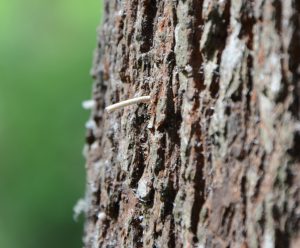
By Les Harrison
Wakulla County Extension Director
Benjamin Franklin, one of America’s founding fathers and an all-around intelligent person, observed in Poor Richard’s Almanac “a little leak will sink a great ship”. What he was attempting to say was take care of the small details because the minutia can lead to major, and usually negative, consequences.
This truism is commonly applied to a variety of topics in contemporary life. Politics, the environment, finances and many more timely subjects have been viewed in light of this old maxim.
As trite as it may appear, even horticulture in present day Wakulla County is not exempt from the applicability of this saying. Specifically, one little insect in the Xyleborini tribe has been destroying great trees.
Ambrosia beetles are known for attacking various woody plants, causing some limb and stem die-back and sometimes plant death. There are at least 30 species of ambrosia beetles in Florida, several of which are non-native.
Typically ambrosia beetles have a symbiotic relationship with a fungus with the beetles carry fungal spores on their bodies. When the beetles bore into the sapwood of the host tree, the galleries formed from the beetle boring are inoculated with the fungal spores.
As these beetles continue their damage the spores germinate and infect the host tissue. The fungus flourishes in the galleries and adjacent sapwood, disrupting the flow of water and nutrients in the tree.
As the fungus grows the beetles and their larvae feed on it and spread the new spores. It is a perfect example of a self-sustaining species which grown its own food.
Most ambrosia beetles attack trees and shrubs which are already stressed, dying, or dead. Plant stress may have been initiated by drought, flooding, freezing temperature damage, wind damage, or very poor cultural practices. It is nature’s way of renewing itself for the strong and productive.
Unfortunately, some ambrosia beetles, such as the Redbay Ambrosia Beetle attack healthy trees. Of additional importance, the fungus which causes laurel wilt accompanies this beetle and often causes tree death.
The Redbay Ambrosia Beetle (Xyleborus glabratus) is a very small, about 2 millimeters in length or 15 could fit head to toe in an inch. They are dark brown to black, cylinder-shaped beetle, similar to other ambrosia beetle species found in Florida.
The adult female Redbay Ambrosia Beetle has a special pouch in its mouth which transports the spores of the fungus responsible for laurel wilt disease (Raffaelea lauricola). When these beetles bore into the wood, forming galleries, the spores transported in its mouth and on its body infect the tree.
As this pathogen germinates, it colonizes the sapwood of the host plant by using the tree’s circulatory system to spread the disease. Unfortunately, the tree is usually doomed at this point.
The Redbay Ambrosia Beetle is native to east Asia, but the origin of the destructive fungus accompanying the beetle is not known. The beetle is believed to have been inadvertently released into Georgia in 2002 through infested packing materials, such as wooden crates and pallets.
Several species of bay trees, sassafras and avocado trees area all potential host for this imported pest. At present there are no registered fungicides for avocado that will control laurel wilt.

The best control measures are to not bring in wooden pallets and other similar products which may carry the tiny beetles, their larvae and the fungus. Firewood from distant sources is another potential carrier of this problem species.
Attention to these small details may save many great trees in Wakulla County, and hopefully beyond.
To learn more about ambrosia beetles in Wakulla County, contact the UF/IFAS Wakulla County Extension Office at 850-926-3931 or https://blogs.ifas.ufl.edu/wakullaco/ .
 0
0
